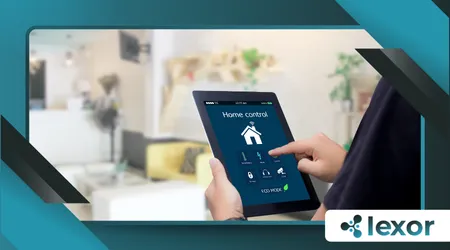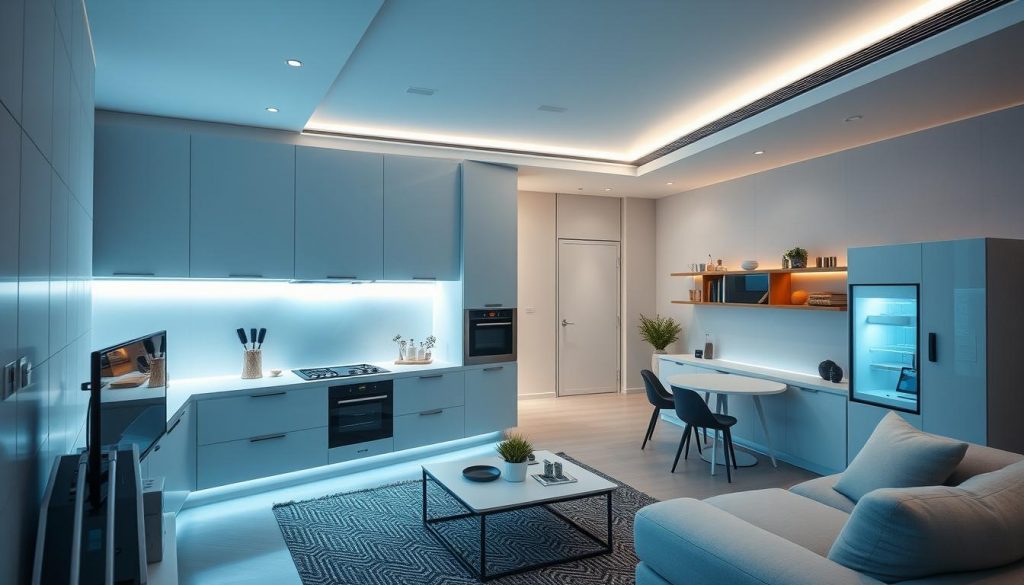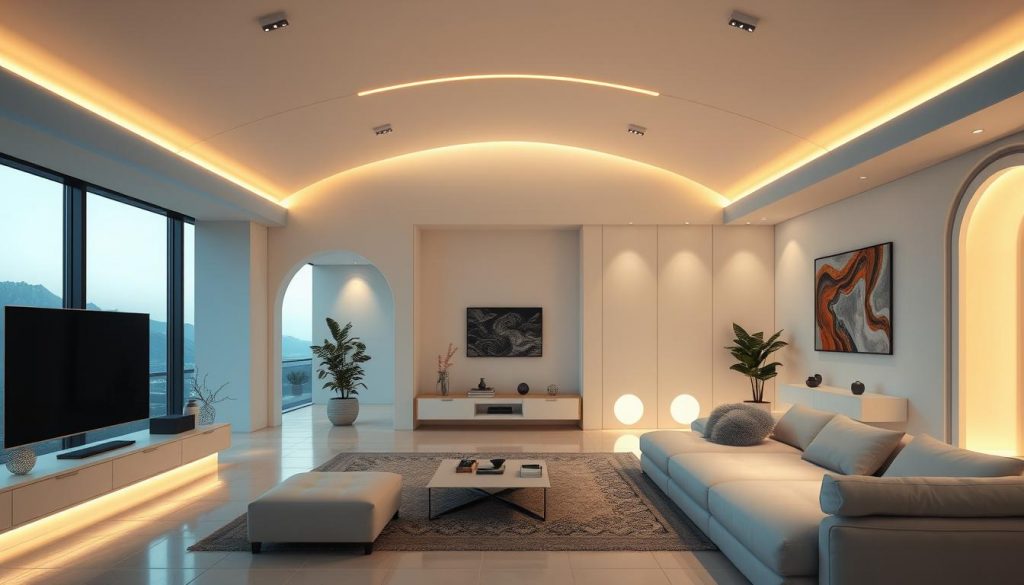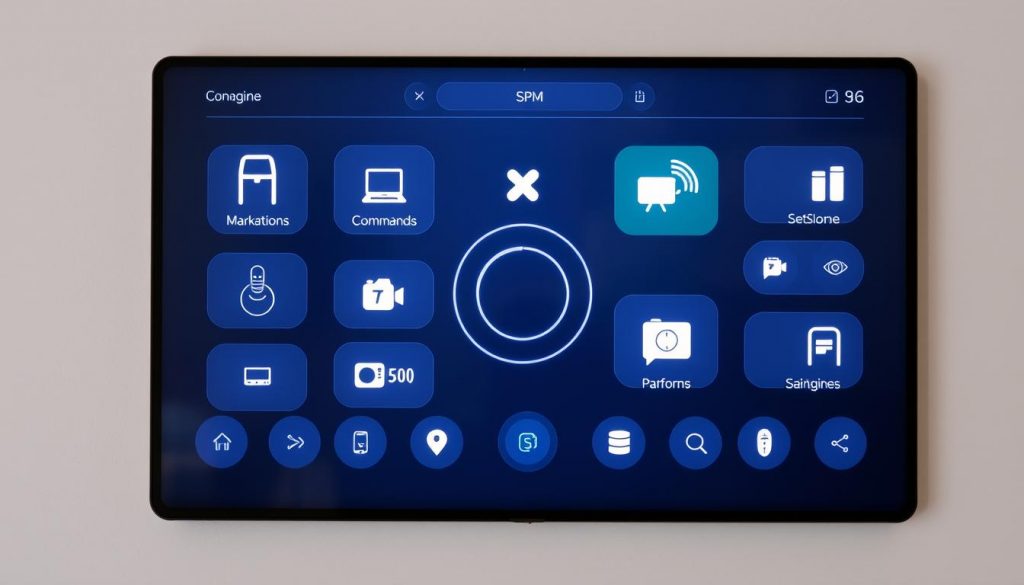Smart Home Essentials: Complete Setup Guide 2025

Did you know the ADT Command system, once listed at $599, is now offered for around $143.99?
This sudden drop shows how connected devices are fast becoming both advanced and wallet-friendly.
In 2025, you can turn your home into a smart space. With just a tap on your phone, you can lock doors, control lights, and adjust the temperature.
You can choose from Google Home, Amazon Alexa, or Apple HomeKit for easy control. This lets you create a personalized space, no matter where you are.

The Rise of Connected Living

More people want easy lives, and the smart home market is growing fast. It’s expected to hit $174 billion by 2025.
Outdoor security systems are getting smarter, combining cameras from brands like TP-Link Tapo or Reolink with voice control.
DIY options, like SimpliSafe, are easier to set up than professional services like ADT Command.
This makes smart homes more accessible to everyone.
Now, devices talk to each other, making it easier to manage your home. You can control lights, temperature, and entry points with just a voice command.
This central control makes daily tasks simpler and more efficient.
Home automation is at its best when everything works together seamlessly. This brings peace of mind and saves time.
As technology advances, your smart home can too, making your life more comfortable and efficient.
+ Blockchain Technology Explained: A Beginner’s Guide 2025
Key News Trends Shaping Home Automation
More devices are coming with fingerprint and 4K security features.
These meet your privacy needs and offer better performance. Voice-friendly hubs now answer your questions more naturally, showing AI’s growth in meeting daily needs.
Matter is a new term you might see. It aims to connect brands like Google Nest, Amazon Alexa, and Apple HomeKit. This could make your devices work together better.
Interoperability is key in modern living technology. Control4 systems can learn your routine and set up scenes for you, like opening shades with sunrise.
Gesture control is also gaining ground, letting you control entertainment with hand movements.
Energy efficiency is a big trend, with solar panels and home batteries saving on bills. Your smart home can get even smarter with real-time energy monitoring and predictive features.

AI-enhanced sensors can quickly spot water leaks, and biometric locks keep your doors safe.
This fast-paced world of automation is heading towards a future where your home adapts to your needs. By embracing these advancements, you can make your home smarter and safer.
Also Read:The Future of VR in Healthcare: Revolutionizing Medical Training 2025
Assessing Your Home for Smart Devices
Many people start with a strong internet and wiring plan for automation. Around 85% of new installations focus on home network setup.
This is because smart cameras and streaming gadgets use a lot of bandwidth.
Checking your electrical outlets before starting is wise. It helps avoid problems with smart speakers or security systems.
Over 1,000 devices from more than 150 brands work with Google Home, making setup easier.
Planning your rooms for Wi-Fi coverage or wiring upgrades is key. This step prevents surprises when linking devices.
Surveys show 60% of households with a dedicated hub see daily efficiency gains. Doing this now makes your setup smoother and saves money.
How Smart Home Essentials Elevate Modern Living
Advanced technology makes your daily routine easier. It brings light control, remote security checks, and flexible HVAC management.
Brands like Google Nest thermostats help cut heating and cooling costs.
Studies show smart homes can increase in value. This reflects a growing demand for connected homes.
Smart devices, like Philips Hue setups, dim or switch off when rooms are empty. These upgrades offer great home convenience.
You can set temperature schedules and monitor everything through mobile apps.
Industry data shows over 80% of users are happy with voice-controlled features. This shows the power of hands-free living.
Adding more systems can save money on utility bills and make life simpler and more fulfilling.
The Role of Voice Assistants for a Friendly Experience
Voice assistants like Alexa, Google Assistant, and Siri are key in many homes. They offer hands-free convenience, better time management, and quick access to important info.
Thanks to natural language processing, talking to them feels more natural and friendly.
When you speak, you unlock new possibilities, from planning your day to controlling smart devices instantly.
Many find these assistants helpful for daily tasks, but privacy is a big concern.
Companies work hard to keep your data safe by encrypting recordings and letting you check or delete them.
This effort builds trust and encourages more use of voice assistants. Experts predict even more improvements by 2025.
This will make voice assistants even more a part of our daily lives.
Security Upgrades for Peace of Mind
Many people want better protection in their homes. 74% of home buyers look for strong defenses before buying. You can add cameras at your doors for extra safety.
60% of families use videos to keep an eye on their loved ones and pets all day. Think about using Reolink Argus Track for easy, battery-powered security. Or, choose ADT Command for 24/7 help.
Installing smart locks can stop break-ins and close gaps from unlocked doors. You can go for a DIY setup with motion sensors and alarms. Or, you can get a professional package with live monitoring.
45% of homeowners think permanent systems make their homes more attractive. Adding smart locks at every door makes your home even safer.
These upgrades create a strong smart home security system that suits your life.
Ensuring Energy Efficiency to Lower Bills
Smart thermostats from Nest or Ecobee adjust to your schedule, saving up to 15% on heating and cooling.
Environment sensors track temperature and humidity, helping you adjust your home’s climate. This approach to energy management ensures comfort while saving money each year.
LED smart bulbs from Philips Hue or LIFX use 75% less electricity than old bulbs. They can be set to turn off or dim, saving 20–30% on your bill.
These eco-friendly devices also reduce your carbon footprint and light your rooms perfectly.
Smart plugs and advanced power strips stop energy waste, which can be 10–20% of your bill. They let you see where energy is being used.
This makes it easier to plan upgrades that fit your green goals.
| Device | Potential Savings |
|---|---|
| Smart Thermostat | Reduces heating/cooling costs by up to 15% |
| LED Smart Bulbs | Uses at least 75% less power |
| Smart Plugs | Identifies up to 30% of energy use |
| Smart Power Strips | Eliminates 10–20% of phantom drain |
Future-Proofing Your Home Technology
Getting ready for tomorrow’s tech means having flexible hubs and keeping software up to date.
Matter aims to bring different brands together, giving you more freedom. By 2025, 75% of new homes will have smart systems that can grow with you.
Interoperability brings peace of mind. You can change or add devices without being stuck in one system.
Regular updates keep your network safe as more devices connect. A software-focused approach means your system gets better over time.
Choosing tech for the future means looking at new wireless standards and cloud designs.
A flexible approach adds value over time, letting you add energy-saving and security features. Here are some key protocols for the future.
| Protocol | Main Advantage | Impact |
|---|---|---|
| Wi-Fi 6E | Faster speeds and lower latency | Smoother streaming and device control |
| Zigbee | Low power usage | Extended battery life for sensors |
| Thread | Mesh networking | Strong connection stability |
Conclusion
You have the power to create a home that’s both convenient, secure, and comfortable.
The cost can vary from $1,500 for basic setups to over $15,000 for more complex ones. For bigger homes, the price can go up to six figures.
Even small additions like a Google Nest Mini or an Amazon Smart Plug can make a big difference.
They cost less than $100 but can change your daily life.
But, there’s a risk of cyber attacks, like the 2016 DDoS attack. To stay safe, use strong passwords, encryption, and keep your devices updated.
This way, you can enjoy your smart home without worrying about security issues.
Smart lighting and thermostats can cut your energy bills by up to 30% each year. A fully connected smart home in 2025 will make your life easier.
Devices like the Ring Smart Doorbell or Wyze Thermostat can make a big difference.
It’s also important to have a strong Wi-Fi network. You might need extra hardware, like range extenders, to keep everything connected.
Every step you take brings you closer to a home that fits your needs and future.
